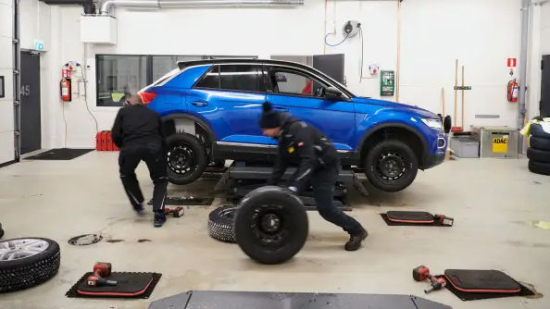ADAC tests winter tyres for compact SUVs – 7 good performers
 The motoring clubs employed a VW T-Roc for their 16” test (Photo: ADAC/Marc Wittkowski)
The motoring clubs employed a VW T-Roc for their 16” test (Photo: ADAC/Marc Wittkowski)
In addition to evaluating the performance of 16 winter tyres in size 225/45 R17, European motoring clubs ADAC, TCS and ÖAMTC have tested a further 16 in size 205/60 R16, a dimension primarily worn by smaller SUVs. The test team fitted the tyres to a VW T-Roc and appraised their performance in dry, wet and wintry conditions as well as for environmental and sustainability-related factors such as noise, wear and rolling resistance.
In its test report, Germany’s ADAC awards seven tyres a ‘good’ rating – none of the tested tyres gained the highest rating of ‘very good’ – and rates a further seven as ‘satisfactory’. ADAC also considers two tyres ‘deficient’ and advises against these.
Something that stood out for us in this test is the motoring club’s stance on when to retire a tyre. The minimum legal tread depth in the UK and Europe is 1.6mm but ADAC, based upon its study of partially worn tyres, recommends “earlier replacement for safety reasons.”
“At the latest when the tread of a winter tyre is less than four millimetres, new ones are needed,” states ADAC. This advice contradicts that of Michelin, whose Alpin 6 is joint winner of the 205/60 R16 test (together with the Dunlop Winter Sport 5). Michelin aims to demonstrate that tyres can be driven until 1.6mm, thereby optimising raw material usage and reducing rolling resistance, without compromising on safety. ADAC appears to disagree with Michelin on this point, but nonetheless highly praises its tyres.
Rated good
The test team found seven tyres “very balanced” in both driving safety (which contributed 70 per cent towards the final score) and environmental impact (30 per cent), and therefore recommends these “without reservation.” Each tyre admittedly has slightly differing strengths, and ADAC stresses that “depending on your personal driving profile, this can be crucial when choosing tyres.”
For example, those who frequently travel on motorways should pay particular attention to driving comfort on dry roads because the testers only gave two of the seven tyres, the Dunlop Winter Sport 5 and Michelin Alpin 6, a good rating for performance in dry conditions. Both provide the driver with good feedback, are composed in a straight line and handle changes in direction stably and predictably. In addition, these two achieve the highest mileage potential among the seven tyres.
In the wet, the Bridgestone Blizzak LM005 sets the standard with the shortest braking distance, closely followed by the Firestone Winterhawk 4 and Goodyear UltraGrip 9+.
Should winter driving involve more than the occasional snowy or icy road, ADAC considers the Hankook Winter i*cept RS3 to be “the perfect choice.” The association adds that the Continental TS 870 P is “balanced somewhere in the middle” with good performance in all disciplines, but no category-topping results.
Rated satisfactory
Mick Jagger famously sang that he couldn’t get no satisfaction, but in this test of size 205/60 R16 winter tyres there are no less than seven products that could have scratched his itch. Five of these tyres actually achieved a ‘good’ rating for environmental performance but were bumped down a grade due to their results in the driving safety tests.
According to the ADAC, the Kleber Krisalp HP3, Barum Polaris 5, Vredestein Wintrac and Uniroyal WinterExpert display shortcomings on dry roads.
The BFGoodrich G-Force Winter 2, the Fulda Kristall Control HP2, the Kleber, the Barum and the Uniroyal were weaker in the wet – especially in winter. Their wet handling was not on par with most tested tyres and resulted in issues such as understeer or oversteer, an earlier loss of grip when accelerating and slightly longer braking distances.
On winter roads, the Falken Eurowinter HS02 and the Barum Polaris failed to shing and did not achieve more than a satisfactory result.
When it comes to mileage, the Fulda tyre delivered the best result (56,000 kilometres) while the Uniroyal offered the lowest predicted mileage amongst the seven satisfactory tyres (37,000 kilometres).
Rated deficient
In its German-language test coverage, ADAC names two tyres as ‘mangelhaft’. We’ve translated this as deficient, but unsatisfactory or inadequate were amongst the recommended alternatives. Whatever word you choose, the implication isn’t good – which the motoring association makes explicit by stating that “the ADAC engineers expressly advise against purchasing two models due to their weaknesses when it comes to driving safety.”
These tyres are the Lassa Snoways 4 and Austone Athena SP-901. Although ADAC rates the Lassa Snoways good on dry and wet roads, its handling performance on snow-covered roads is poor compared to its competitors.
Conversely, the Austone tyre secured the best score on snow-covered roads but did not get beyond adequate on dry roads and gained a deficient rating on wet roads. This low score in the wet is mainly due to poor handling properties, but the Athena SP-901 also had the longest wet braking distances and worst aquaplaning properties. ADAC shares that by the time the top-performing Bridgestone Blizzak LM005 had come to a complete stop from 80km/h in the wet, the Austone tyre was still travelling at just under 40km/h. “One can only hope that no kindergarten group is crossing the street at that moment,” comments ADAC.



Comments